Attack Effects & Damage
The box on the lower left of the card contains three colored symbols, each corresponding to an attack name and attack value. Unfortunately the localization team made some changes here that fundamentally break the game.
In the original iteration, each card features a strong attack, A (red), dealing the most damage but liable to be countered; a reliable attack, B (green), usually dealing a middling amount of guaranteed damage; and Guard, C (yellow), which deals the least damage but reduces incoming damage from an A (red) attack to zero. Players don’t choose which attack to use, though. The opposing Digimon’s battle type (top left) determines what attack will be used against them in a battle round. It is this rock-paper-scissors dynamic that, in my view, best captures the feeling of taming a digital monster. While you can exert some level of control over where or how your pet moves—in this game by using option cards—you cannot control its movement exactly.
Continuing with the Andromon example, its localization sees the numbers changed, with 120 subtracted from the A (red) attack, Defend, and 120 added to the C (yellow) attack, Gatling Attack. Spiral Sword is the sourcebook name for Andromon’s main attack, but that’s a small change compared to the other element missing entirely from the translation: Guard (A->0). While Guard sounds a bit like Defend, no rules or card text indicates that Defend reduces incoming damage.
I posit that the attack order has been reversed. Red is now the weakest attack, but has a name that suggests it can counter other attacks; green is the strongest attack, and yellow the middling attack.
Since Andromon’s battle type remained the same, but his attack information changed, the card is functionally quite different from its original printing. All red type cards received this change in attack order and attack values. What first seems innocuous in fact completely neuters a key mechanic of the original game, even if one extrapolates Defend to function the way it does in Hyper Coliseum.
Vilemon, a Digimon with the yellow battle type, exhibits the same changes to attack order as Andromon, and the A and C numbers have been altered as well, in this case by 180 points. Vilemon is also a direct example of the “lost point” translation error. The card on the left will lose 30 points to a lvl3, but 10 points to every other level (implying it is strong for a lvl4). Opponents have a ‘comeback’ opportunity if they play their cards right. The card on the right will only gain more than the baseline 100 points for a player if it defeats a lvl6. This makes the card both hyper efficient and frustratingly slow, as failing to play around this nets the opponent a flat 100 points per round. An agonizing death at Vilemon’s hand…things.



